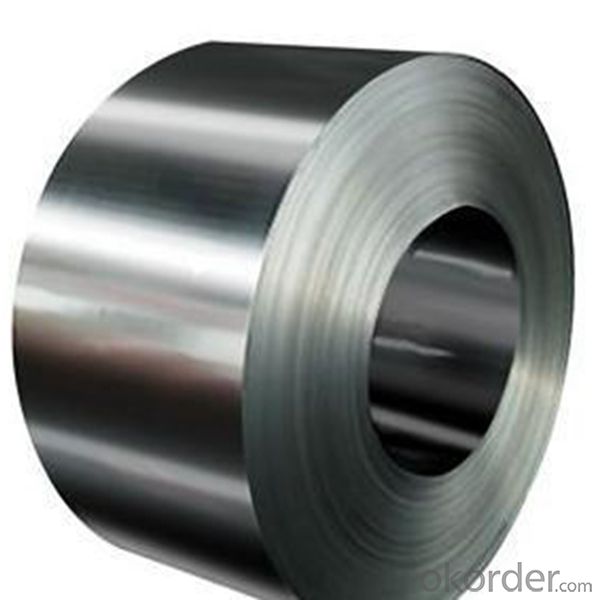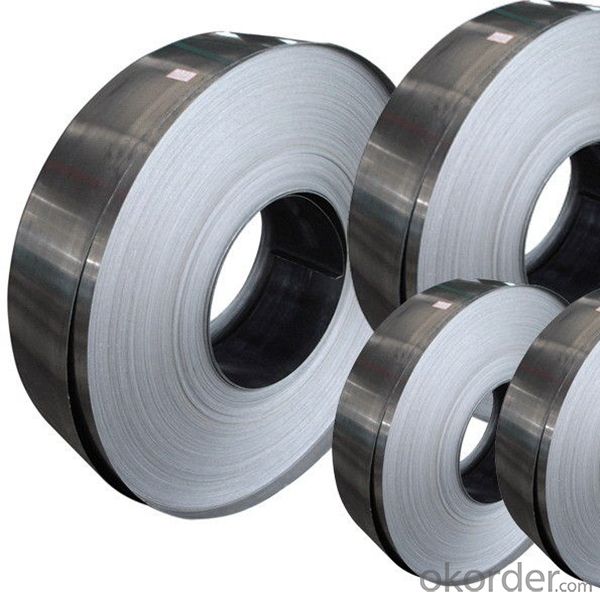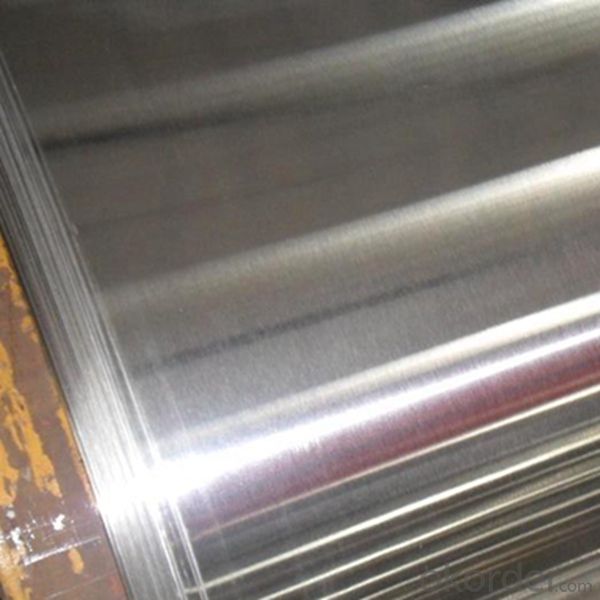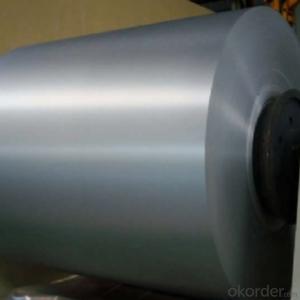Hot Rolled Steel Coils NO.1 Finish 304 Grade
- Loading Port:
- Shekou
- Payment Terms:
- TT OR LC
- Min Order Qty:
- 22 m.t.
- Supply Capability:
- 200000 m.t./month
OKorder Service Pledge
OKorder Financial Service
You Might Also Like
Item specifice
Products Description for Stainless Steel Coils/Sheets:
Product | stainless steel coils/plates/sheets | ||
Discharge Port | Any Port, China | ||
Size | Coils | Cold Rolled: | Thickness0.3-8mm,Width:280-2100mm |
Hot Rolled : | Thickness3-14mm,Width:650-2100mm | ||
Plates | Thickness2-80mm,Width:1500-3000mm | ||
Coil Weight | About 20 Tons | ||
Grade | 201,202,304/304L/304H,316/316L/316H,321/H,310S,409/L,430 etc. | ||
Technique | Hot Rolled/Cold Rolled | ||
Finish | 2B, BA, 2D, No1, No2, No4,NO.8,SB etc | ||
Edge | Mill Edge / Slitting Edge | ||
Package | In bundles, or as customer's requirement | ||
Place of Origin | Made in China | ||
MOQ | 20 Tons | ||
Packaging & Delivery for Stainless Steel Coils/Sheets:
Packaging Detail Standard export packing or following customer's demand
Delivery Time: Within 30-40 days after deposit or according to the order quantity
Detail picture for Stainless Steel Coils/Sheets



Application of Stainless Steel Coils
(1)Boiler heat exchanger,
(2)Chemical industries,
(3)Hardware fields,
(4)Construction material,
(5)Kitchen utensils,
(6)Building construction,
(7)Medical equipment,
(8)Chemical tank,
(9)Pipe etc
Export Markets for Stainless Steel Coils/Sheets:
Our target market is the international market. Every year we export most of products to countries like India, Pakistan, South Korea, Brazil, Australia, South Africa, Spain, Sri Lanka, Taiwan, Hong Kong, etc.
- Q:What are the different types of stainless steel sheet alloys available?
- When choosing a stainless steel sheet alloy, it is crucial to take into account the particular needs of your application, as each alloy possesses its own set of advantages and disadvantages. There exists a variety of stainless steel sheet alloys from which to choose, each offering distinct properties and characteristics. Some of the most frequently encountered stainless steel sheet alloys are as follows: 1. Austenitic Stainless Steel: This is the most commonly used and versatile type of stainless steel. It lacks magnetic properties and contains substantial amounts of chromium and nickel, resulting in exceptional corrosion resistance and good formability. The 304 and 316 grades are examples of austenitic stainless steel alloys. 2. Ferritic Stainless Steel: Ferritic stainless steel possesses magnetic qualities and contains high chromium levels. It exhibits good corrosion resistance and is generally less expensive than austenitic stainless steel. The 430 and 446 grades are common examples of ferritic stainless steel alloys. 3. Martensitic Stainless Steel: Martensitic stainless steel is magnetic and contains significant amounts of carbon and chromium. It is renowned for its hardness and strength, rendering it suitable for applications requiring high wear resistance. The 410 and 420 grades are examples of martensitic stainless steel alloys. 4. Duplex Stainless Steel: Duplex stainless steel is a combination of austenitic and ferritic stainless steels, offering a balanced blend of their properties. It possesses increased strength and corrosion resistance when compared to austenitic stainless steel. Common duplex stainless steel alloys include the 2205 and 2507 grades. 5. Precipitation Hardening Stainless Steel: Precipitation hardening stainless steel alloys can be heat treated to attain high levels of strength. They contain elements such as copper, aluminum, or titanium, which form precipitates during heat treatment, leading to enhanced strength. The 17-4PH and 15-5PH grades are examples of precipitation hardening stainless steel alloys. Therefore, it is essential to carefully consider the specific requirements of your application when selecting a stainless steel sheet alloy, as each alloy possesses its own unique strengths and limitations.
- Q:How do you prevent scratching on stainless steel sheets during handling and installation?
- To avoid scratching stainless steel sheets while handling and installing them, there are several precautions you can take: 1. Apply protective covering: Prior to handling or installation, it is advisable to apply a protective film or covering on the surface of the stainless steel sheets. This covering acts as a barrier, safeguarding against scratches and scuff marks during transportation and installation. It is important to ensure that the chosen covering is suitable for stainless steel and leaves no residue when removed. 2. Handle with caution: It is crucial to be mindful of how you handle the stainless steel sheets. Avoid dragging or sliding them against rough surfaces or each other, as this can result in scratches. Instead, use appropriate lifting techniques and handle the sheets with clean, dry hands or gloves to minimize the risk of leaving marks. 3. Utilize suitable tools: When working with stainless steel sheets, ensure that you use tools specifically designed for this purpose. Refrain from using tools with rough or abrasive surfaces that could potentially scratch the stainless steel. Opt for tools made from soft materials or those with protective coatings to reduce the chances of surface damage. 4. Keep work areas clean: Before installing stainless steel sheets, it is essential to ensure that the work area is clean and free from any debris or particles that could potentially scratch the surface. Use a clean cloth or soft brush to wipe down the area, removing any dirt, dust, or loose materials that could cause scratches during the installation process. 5. Secure sheets during transportation: If you need to transport stainless steel sheets, it is crucial to secure them properly to prevent any movement or shifting that could lead to scratches. Utilize appropriate packaging materials such as foam inserts, edge protectors, or straps to keep the sheets in place and minimize the risk of damage. By adhering to these preventive measures, you can significantly reduce the likelihood of scratching stainless steel sheets during handling and installation, ensuring a flawless finish and preserving the quality of the material.
- Q:What are the different types of finishes available for stainless steel sheets?
- Stainless steel sheets come in various finishes, each with its own distinct appearance and level of protection. Some commonly used finishes include: 1. No. 1 Finish: This finish is achieved by hot rolling the stainless steel sheet, resulting in a dull and rough surface that lacks reflection. It is commonly utilized in industrial settings where appearance is not the primary concern. 2. No. 2B Finish: By cold rolling the stainless steel sheet and subsequently annealing it in a controlled atmosphere, a smooth and reflective surface is obtained. This finish is widely favored in applications that require an aesthetically pleasing appearance, such as kitchen appliances and decorative trim. 3. No. 4 Finish: Also known as brushed or satin finish, this technique involves applying a series of abrasive grits to the surface of the stainless steel sheet. It creates a uniform, linear grain pattern that is often used for architectural and decorative purposes. 4. No. 8 Finish: This highly reflective finish is achieved by polishing the stainless steel sheet to a mirror-like appearance. It is commonly employed in applications that demand a sleek and sophisticated look, such as high-end architectural projects and automotive trim. 5. BA (Bright Annealed) Finish: This finish is accomplished by annealing the stainless steel sheet in a controlled atmosphere, followed by pickling or blasting to remove any oxide scale. It results in a smooth and bright surface, making it suitable for applications that require optimum corrosion resistance, such as medical equipment and pharmaceutical processing. 6. Hairline Finish: By mechanically brushing the surface of the stainless steel sheet with fine abrasive belts, a subtle and textured look is achieved. This finish can be utilized for architectural and decorative purposes. 7. Embossed Finish: This finish entails imprinting a raised or recessed pattern onto the surface of the stainless steel sheet using a rolling mill or press. It adds texture and visual interest to the sheet and is commonly employed in applications like elevator interiors, wall cladding, and signage. These are just a few examples of the numerous finishes available for stainless steel sheets, each offering its own unique aesthetic and functional properties. The selection of the appropriate finish depends on the specific application and desired appearance.
- Q:What is the strength of stainless steel sheets?
- The strength of stainless steel sheets can be attributed to several factors. Firstly, stainless steel is an alloy of iron and chromium, which provides it with excellent corrosion resistance. This resistance to corrosion makes stainless steel sheets ideal for various applications, including in environments where they may be exposed to moisture, chemicals, or extreme temperatures. In addition to corrosion resistance, stainless steel sheets also possess high tensile strength. Tensile strength refers to the maximum amount of tensile stress a material can withstand before failure. Stainless steel sheets have a high tensile strength, allowing them to withstand heavy loads and resist deformation or breaking under pressure. Furthermore, stainless steel sheets exhibit excellent durability and hardness. This means that they can withstand wear and tear, making them suitable for applications that require long-lasting and robust materials. Stainless steel sheets are also known for their high resistance to heat, which enables them to maintain their structural integrity even at elevated temperatures. Another strength of stainless steel sheets is their versatility. They can be fabricated into various shapes and sizes, making them suitable for a wide range of applications. Additionally, stainless steel sheets can be easily formed, welded, and machined, allowing for customization to meet specific requirements. Overall, the strength of stainless steel sheets lies in their corrosion resistance, high tensile strength, durability, hardness, heat resistance, and versatility. These properties make stainless steel sheets a reliable and trusted material in numerous industries, including construction, automotive, aerospace, food processing, and many others.
- Q:Can stainless steel sheets be used for wire mesh?
- Certainly, wire mesh can be made from stainless steel sheets. Stainless steel, being a highly versatile material, finds extensive usage across numerous applications owing to its exceptional durability, resistance to corrosion, and strength. Once stainless steel sheets undergo processing to transform into wire mesh, they acquire a robust and dependable mesh structure. Industries like construction, agriculture, mining, and filtration often employ stainless steel wire mesh due to its remarkable ability to endure harsh environments, withstand rust and corrosion, and uphold its structural integrity throughout time.
- Q:Stainless steel plate how to distinguish between good and bad, there are several thick?
- Similarly, in order to facilitate management, avoid confusion and prevent the use of accidents caused by confusion, the production plant in the material or packaging marked mark, batch number, status, specifications, quantity and production plant code and other signs. The markings to be drawn shall be consistent with the contents of the certificate of quality. There are three main methods: color logo (show the grade of color in the material provisions of parts with (in), print materials specified parts stamped or printed, to illustrate the types of materials, specifications, stove number, commonly used in large and medium thick steel plate or steel, listed above) (hanging in bundles or boxes of materials, indicating the designation, batch number, specifications, quantity and other signs).
- Q:Are stainless steel sheets suitable for elevator buttons?
- Indeed, elevator buttons can be made from stainless steel sheets. The reason behind this preference for stainless steel lies in its remarkable durability, resistance to corrosion, and effortless upkeep. Given that elevator buttons are frequently pressed by countless individuals throughout the day, stainless steel can endure the strain and continuous usage without compromising its visual allure. Moreover, stainless steel boasts simple cleaning and sanitizing procedures, rendering it an excellent hygienic option for elevator buttons. In summary, stainless steel sheets represent a superb choice for elevator buttons, delivering both resilience and a stylish, contemporary look.
- Q:Are stainless steel sheets good for cryogenic storage?
- Stainless steel sheets are widely utilized in cryogenic storage owing to their exceptional characteristics. Renowned for its remarkable strength, durability, and corrosion resistance, stainless steel proves to be ideal for extreme temperature settings such as cryogenic storage. Furthermore, stainless steel retains its mechanical properties even under extremely low temperatures, guaranteeing the safety and integrity of stored materials. Moreover, stainless steel sheets exhibit favorable thermal conductivity, enabling efficient heat transfer throughout cryogenic processes. As a result, stainless steel sheets emerge as a dependable option for cryogenic storage purposes.
- Q:Are stainless steel sheets resistant to crevice corrosion?
- Yes, stainless steel sheets are generally resistant to crevice corrosion. Crevice corrosion occurs in confined spaces, such as crevices or gaps between two surfaces, where oxygen and other corrosive agents are limited. Stainless steel sheets are made primarily of iron, chromium, and other alloying elements that create a protective oxide layer on the surface, preventing the penetration of corrosive agents. This oxide layer acts as a barrier, making stainless steel highly resistant to crevice corrosion. However, it's important to note that the resistance to crevice corrosion can vary depending on the specific grade and composition of the stainless steel, as well as the environmental conditions it is exposed to.
- Q:Can stainless steel sheets be used for heat shields?
- Certainly! Heat shields can indeed utilize stainless steel sheets. Renowned for their exceptional heat resistance and durability, stainless steel proves to be an outstanding option for safeguarding against heat transfer. By effectively deflecting radiant, convective, and conductive heat, stainless steel sheets are well-suited for an array of purposes, encompassing automotive heat shields, industrial machinery, and household appliances. Moreover, their corrosion resistance and effortless maintenance render stainless steel sheets a pragmatic and enduring selection for heat shield implementations.
1. Manufacturer Overview |
|
|---|---|
| Location | |
| Year Established | |
| Annual Output Value | |
| Main Markets | |
| Company Certifications | |
2. Manufacturer Certificates |
|
|---|---|
| a) Certification Name | |
| Range | |
| Reference | |
| Validity Period | |
3. Manufacturer Capability |
|
|---|---|
| a)Trade Capacity | |
| Nearest Port | |
| Export Percentage | |
| No.of Employees in Trade Department | |
| Language Spoken: | |
| b)Factory Information | |
| Factory Size: | |
| No. of Production Lines | |
| Contract Manufacturing | |
| Product Price Range | |
Send your message to us
Hot Rolled Steel Coils NO.1 Finish 304 Grade
- Loading Port:
- Shekou
- Payment Terms:
- TT OR LC
- Min Order Qty:
- 22 m.t.
- Supply Capability:
- 200000 m.t./month
OKorder Service Pledge
OKorder Financial Service
Similar products
New products
Hot products
Related keywords

































